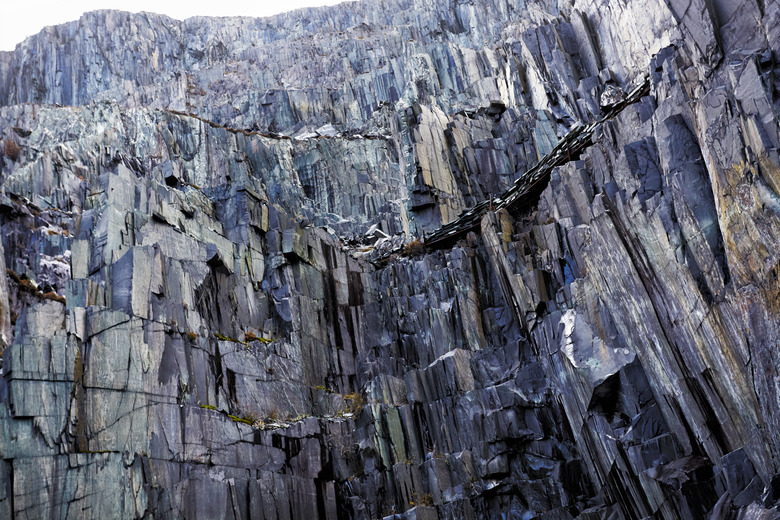The Characteristics Of Slate
Slate is a type of metamorphic rock that is used for a variety of purposes in construction. A fine-grained rock that breaks into pieces along flat planes, slate is usually bluish-gray in color, but it also comes in shades of green, red, purple and brown. The parent rock – also called the protolith – of slate can be shale or mudstone. Like other metamorphic rocks, slate is transformed from shale or mudstone by a combination of high temperature and high pressure. Often created as a result of regional metamorphism, slate is usually found in large areas affected by tectonic forces, such as near mountain ranges or where two tectonic plates converge.
Physical Properties of Slate
Physical Properties of Slate
An example of a fine-grained, foliated metamorphic rock, slate breaks easily into thinner slabs. Foliation is a word used to refer to metamorphic rocks that exhibit layers of materials due to the parallel alignment of the minerals they are composed of. This parallel alignment is caused by the heat and pressure of the metamorphic process.
Cleavage is a geological term used to describe how a rock breaks. Since slate is foliated along clear parallel planes, breakage or cleavage also occurs easily along these planes. This geological property is known as slatey cleavage.
Metamorphism occurs at high temperatures and pressures, but these conditions are relative. Metamorphic grade refers to the relative temperature and pressure present when metamorphic rocks form. Slate forms under under conditions of relatively low pressure and temperatures of 200 to 320 degrees Celsius, which is classified as a low metamorphic grade.
Uses of Slate
Uses of Slate
Because slate is foliated and cleaves cleanly along parallel lines, it can easily be broken into smaller slabs that are useful for a variety of purposes. A chemically inert rock, slate is often used to build laboratory bench tops. Slate is thermally stable, which means that it is relatively heat resistant – another property that makes it useful in science labs.
Slate has been used for billiard table tops, and because it is fireproof, it was used in switchboards, relays and electric motors in the early 1900s. It has also been used for tombstones.
There are many applications of slate in buildings and construction. Because it does not absorb much water, it is especially useful as a roofing material. Durable, beautiful and long-lasting, roofing tiles made of slate are common in Europe. There are many buildings made completely of slate, and the rock is also used for flooring, decorative and landscaping purposes.
Finally, probably the most commonly known application of slate is in the classroom. Blackboards and personal writing slates were often made of the rock in the 18th and 19th centuries.
Where Slate Is Found
Where Slate Is Found
Slate is found all over the world, from the Americas to Europe, Asia and Australia. In the Americas, major slate producing regions include New York, Vermont, Maine, Pennsylvania, Newfoundland and Brazil. In Europe, slate has been extracted from Wales, Spain, Portugal, France, Germany and Norway. China is the main slate producer in Asia, and there are slate quarries across the continent of Australia.
Extracted from mines or quarries, slate that is colored in a hue other than gray is particularly sought after. Color variation may be found within regions or from place to place, and slate can be found in colors ranging from purple to red to green. The color of slate depends on the minerals present in the protolith and the grade of metamorphism. At higher grades of metamorphism, slate becomes the color of the minerals in the protolith. For instance, a green color indicates the presence of chlorite, while browns and reds come from iron oxides.
Cite This Article
MLA
Sloane, Christina. "The Characteristics Of Slate" sciencing.com, https://www.sciencing.com/characteristics-slate-8199338/. 20 October 2021.
APA
Sloane, Christina. (2021, October 20). The Characteristics Of Slate. sciencing.com. Retrieved from https://www.sciencing.com/characteristics-slate-8199338/
Chicago
Sloane, Christina. The Characteristics Of Slate last modified March 24, 2022. https://www.sciencing.com/characteristics-slate-8199338/
